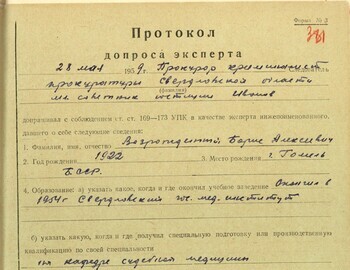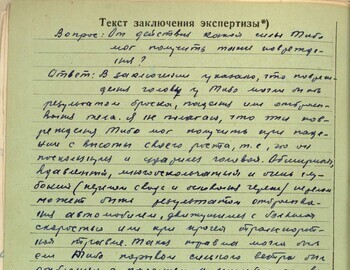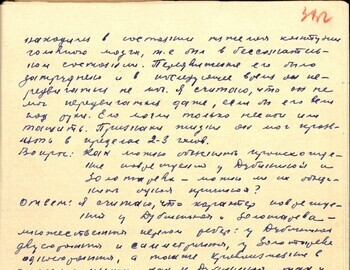
Testimony of forensic expert Vozrozhdenniy
Sheet 381
Protocol
Testimony of forensic expert
May 28, 1959 prosecutor criminologist of the Prosecutor's Office of the Sverdlovsk region ml. counselor of justice Ivanov
interrogated in compliance with Article 169-173 of the Code of Criminal Procedure of the RSFSR as an expert of the below-named, who gave the following information about himself:
- Surname, name and patronymic Vozrozhdenniy Boris Alekseevich
- Year of birth 1922
- Place of birth of Gomel, BSSR
- Education a) indicate which, when and where he graduated from the school: Graduated in 1954 Sverdlovsk State Medical Institute
b) indicate which, when and where did you received special training or work qualification in the Department of Forensic Medicine
c) do you have any publications, research, inventions or awards for work in your specialty: no - Medical experience since 1954
- Current position as forensic expert
- Political affiliation (if a member of the CPSU, indicate the length of service): none
- Criminal record: no.
- Permanent residence (exact address and telephone number): Sverdlovsk, Kolectivnaya St 5 apt. 15
Expert /signature/
Investigator /signature/
The text of the conclusion of the examination *)
Question: From what kind of force could Thibeaux-Brignolle have received such injury?
Answer: In the conclusion, it’s shown the damage to Thibeaux-Brignolle’s head could have been the result of the throwing, fall or jettisoning of the body. I don’t believe these wounds could have been the result of Thibeaux-Brignolle simply falling from the level of his own height, i.e. falling and hitting his head. The extensive, depressed, multi-splintered (broken fornix and base of the skull) fracture could be the result of an impact of an automobile moving at high speed. This kind of trauma could have occurred if Thibeaux-Brignolle had been thrown and fallen and hit his head against rocks, ice, etc., by a gust of strong wind.
Question: Is it possible that Thibeaux-Brignolle was hit by a rock that was in someone’s hand?
Answer: In this case, there would have been damage to the soft tissue, and this was not evident.
Question: How long could Thibeaux-Brignolle have lived after the trauma. Could he have moved on his own, talked, etc.?
Answer: After this trauma, Thibeaux-Brignolle
*) The text should begin with a statement of questions presented by the investigation and the pertinent materials on the basis of which the conclusion is made. The content of the expert conclusion consists of the following parts: 1) a description of the methods and procedures used by the expert in the research process; 2) a narrative (description) of the results obtained by the expert; 3) conclusions of the examination (answers to the presented questions)
would have had a severe concussion; that is, he would have been in an unconscious state. Moving him would have been difficult and, close to the end, movement would not have been possible. I believe he would not have been able to move even if he had been helped. He could only have been carried or dragged. He could have shown signs of life for 2-3 hours.
Question: How is it possible to explain the cause of the damage to Dubinina and Zolotaryov? Is it possible to combine them into one cause?
Answer: I think the character of the injuries on Dubinina and Zolotaryov – a multiple fracture of the ribs – on Dubinina were bilateral and symmetrical, and on Zolotaryov were one-sided. Both had hemorrhaging into the cardiac muscle with hemorrhaging into the pleural cavity, which is evidence of them being alive [when injured] and is the result of the action of a large force, similar to the example used for Thibeaux-Brignolle. These injuries, especially appearing in such a way without any damage to the soft tissue of the chest, are very similar to the type of trauma that results from the shock wave of a bomb.
Question: How long could Dubinina and Zolotaryov have lived?
Answer: Dubinina died 10-20 minutes after the trauma. She could have been conscious. Sometimes it happens that a person with a wound to the heart (for example, a serious knife wound) can talk, run and ask for help. Dubinina’s situation was one of complicated traumatic shock resulting from the bilateral rib fracture, followed by
Sheet 383
internal hemorrhaging into the pleural cavity. Zolotaryov could have lived longer. It needs to be taken into account that they were all trained, physically fit, and strong people.
The protocol has been read to me, written correctly.
/signature /
Prosecutor forensic expert
Jr. counselor of Justice /signature/







